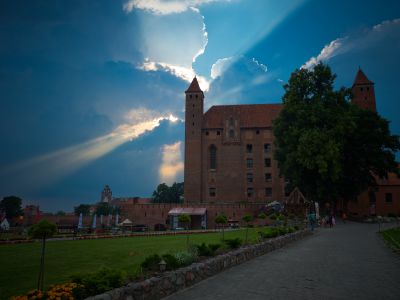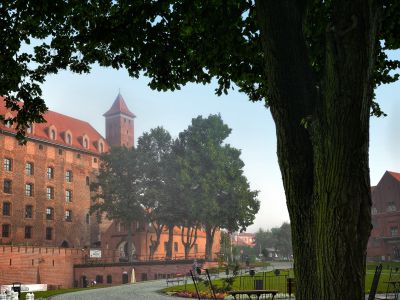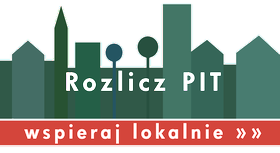Miasto i Gmina Gniew
Menu witryny
Treść strony
Castle
The construction of the castle was started by the Teutonic Knights after the acquisition of the land of Gniew in 1282 and continued it in the XIV century. As the seat of the convent and culture, in the order times it was the main political and economic centre of the commander.
Despite the far-reaching autonomy of the local government, the power of the order effectively watched their subjects. The strategic position, allowing the control of the waterway and the land determined the unique military features of the house of the convent and fortification system of the town and the castle. The fortress was built in the Gothic style on a square plan with the internal courtyard and a well. It had three towers and one larger defensive tower. The original gate was located in the southern wing. In the northern wing there was a refectory, and in the southern wing a chapel. The eastern part probably housed the commander room and dormitory. The entrances to the main rooms on the main floor led to the cloister running along the walls inside the courtyard. The basement contained kitchens and utility rooms. The castle was surrounded by a moat filled with water and defensive walls. The old story says that under the castle there were also underground corridors leading into the city. Still in 1856, in the southern corner, between the castle and the trench, there was a round tower, which had round stairs leading to the level of the moat and linked to the corridor, which, in turn, on the southern part to the basement in the city.
In the XV century the castle was partially rebuilt. During the Thirteen Years’ War, in the second half of the XV century, and then in the period of the Swedish wars in the XVII century, the castle was partially damaged. In the XVIII century, the castle lost its defensive functions, it was not renovated and it was abandoned.
After Gniew was taken over by Prussia in 1772, it was rebuilt into grain warehouses. It caused significant damages of the interior, the Gothic vaults were demolished, the original window openings were eliminated in all elevations (plastering them at the same time), the latrine tower was demolished, also the moats around the castle were filled up and an additional gate opening was dug in the western wing. The partial reconstruction was made in the years of 1857–1859 on the occasion of organising the Prussian prison for criminals. At the cost of 133.397 crowns 23 and ¼ cents, among others, the reconstruction of the chapel ceiling was performed, the original lancet shape of several window openings of the southern elevation were restored, thus significantly improving the image of the castle from the southern side. Two corner towers were also rebuilt. In 1920, Gniew was connected to the Republic. The Polish administration sits in the former prison, and later on, the object was taken over by the military. In 1921, under mysterious circumstances, a fire set out in the castle, which consumed the roof and three wings. Since then, the castle remained in the state of secured ruin. During World War II, the transit camp was set up in it for the Polish people from Pomerania. After the war, the Electronic Component Division was started here, while in 1969 the local Plant of Ship Mechanisms “FAMA” joined the completion of the documentation and implementation of the project to adapt the southern and eastern wing of the Castle, for its cultural and social purposes.
The crown of the walls was repaired then, the steel reinforced structure of the roof was made and as well as it was covered with ceramic tiles. The developing investment appeared in the mid-seventies. Subsequent renovation works started in the nineties of the XX century. They were initiated by the castellan of the Gniew Castle, Jarosław Struczyński. As part of the public works in 1992–1997 it was possible to raise the castle from the rubble, bringing it to its present form.
Since 2010 the castle complex has been managed by the Polmlek Group. At that time, the objects included in the system were restored, and the whole has been transformed into the international centre of culture, tourism and historical education. The Mary Palace offers comfortable rest in stylish chambers, a modern four star Hotel Rycerski has been created in the former barracks, and the roofed courtyard of the castle is an amazing space with the area of over 450 m², serving as the concert, conference and banquet room.
Tradition is obliging, therefore the stronghold has been famous for battle staging, medieval tournaments and historical performances, implemented in the beautifully developed castle. The mainstay of the reconstruction activity includes riding groups: Hussars’ Marshal Banner of the Pomerania (Pol. Chorągiew Husarska Marszałka Województwa Pomorskiego), gathering dozens of people involved in the reconstruction of the XVII century hussars, recognised as one of the best cavalry forms in Europe and the Fellowship of the Knights of the Gniew Castle (Pol. Drużyna Rycerska Zamku Gniew), constituting a several-people representation of Poland in the International Jousting League, bringing together about 200 people from 17 countries. The Knight Tournament organised in Gniew has achieved the highest grade in the scale of the whole League, for the quality and imitative level. Moreover, the castle has got the Yellow Infantry Regiment of Gustav II Adolphus and the choir of Schola Cantorum Gymevensis – the only amateurish, secular Gregorian choir in Poland.
The current of the castle life can give an injection of positive energy. The everyday life of the medieval life takes place in the shadow of the castle walls, in the European Historic Park. In the wooden workshop a potter creates clay pots on the spinning wheel, in a neighbouring household a weaver makes colourful fabrics with her nimble fingers, and a blacksmith makes horseshoes with his practiced movements. Ladies of the court stroll among the workshops and cottages, and the knights practice their efficiency of fighting with a sword and spear.
After visiting the borough, it is worth heading to the castle basements, which hold numerous interesting exhibitions. The multimedia torture chamber presents the working methods of the medieval executioners. In the armoury there is an exhibition of bladed weapons, where you can see how heavy a sword, axe, shield or knightly armour really are. A must of the visit is the multimedia show of Holidays with Ghosts, which takes the viewer to the non-existent world of ghosts, headless knights and crumbling walls.
To get to know the natural values of the Lower Vistula River it will not hurt to go for a bike ride, a gondola ride, or a carriage ride. The queen of Polish rivers has carved a beautiful valley here with numerous oxbow lakes, rich in rare flora and fauna species. The Gniew castle is a magical place, which connects history with the high quality of tourist services.
Polecamy
Dofinansowanie
Strona sfinansowana została ze środków Ministerstwa Administracji i Cyfryzacji, w ramach konkursu na budowę strony internetowej oraz dostosowanie jej do potrzeb osób niepełnosprawnych.
Kontakt

Urząd Miasta i Gminy Gniew
Plac Grunwaldzki 1, 83-140 Gniew
pon., wt., czw. 7.30-15.30
śr. 7.30-17.00
pt. 7.30-14.00
tel. 58 530 79 19;
fax 58 530 79 40
e-mail: sekretariat@gniew.pl
DANE DO FAKTURY
Gmina Gniew
NIP 593 10 05 516
REGON 191675296
Adres Elektronicznej Skrzynki Podawczej: /34gu04waml/skrytka






























